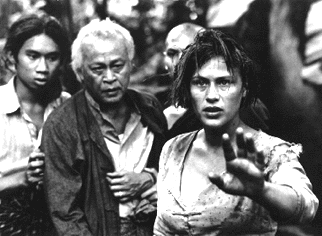Wonder Woman
 Patricia Arquette escapes through Burma in 'Beyond Rangoon'
John Boorman's great new thriller, Beyond Rangoon,
concerns the physical and spiritual journey of Laura Bowman (Patricia
Arquette), who has suffered a terrible loss: the murder of her husband
and child during the course of a burglary. This senseless killing cost
her everything. She was a doctor; she has now been left, as we find out
later, pathetically unable to stand the sight of blood.
On a vacation tour of Southeast Asia with her sister, the
numb-with-grief Laura witnesses a rally on behalf of Aung San Suu Kyi
(Adele Lutz), the political activist who won the Nobel Peace Prize for
her principled defiance of the government of Burma.
The next day, Laura wanders off on an illegal journey into the Burmese
hinterlands with a professor-turned-guide named U Aung Ko (played by an
actor of the same name), who takes Laura to meet his former students,
who are opponents of the ruling regime. When the government strikes
against the protestors in a series of massacres, Bowman and her new
friend, wounded and feverish, have to run to Thailand, pursued by the
Burmese army.
In Beyond Rangoon, the back-story is as interesting as the front
story. We aren't teased with Laura's trauma. Instead, we are shown the
cause of it: first, in a few wrenching images; later, in distant but
cruel dream sequences. Laura is, you sense, justly flattened with pain.
Thus, it is rousing when she rises up to save her own spirit. She's a
hero who grows with the viewer's admiration, as she overcomes peril
after peril. At first withdrawn, Laura changes physically along the
way, getting tougher, bigger-boned, bigger-chested. Women are going to
love this movie.
Boorman web links (This one's in French)
soc.culture.burma (Usenet newsgroup)
Sometimes, cinema is built on the use of sound, of dialogue, of
the swell of exactly the right music on the soundtrack. Other times,
greatness is found in silence, in the careful layering of image upon
image, which draws us through the world the director has created. I
think it's the latter, in its simplicity, that's closer to what is
meant by the magic of cinema. Long passages of Beyond Rangoon
are without dialogue, as in Boorman's Hell in the Pacific
(1968), an almost silent movie in its own right. Beyond Rangoon
has this kind of purity, the sort of thing you see in revivals of films
made when movies were young.
And Beyond Rangoon is so well crafted that the adventure never
stops. When Laura and her guide flee the police through a canebreak in
an ancient Chevy, we see the escape from the passenger's view, through
the dusty windshield of the car. Boorman disposes of the customary
helicopter and crane shots, thus reviving the long-dead thrill of a car
chase, which excites because we can't see enough, even when we most
want to.
In another superbly directed sequence, Laura, with time against her,
makes a one-woman raid on a village in a town full of soldiers amusing
themselves by killing the townsfolk. There is also an amazing guerilla
attack on a truck stopped by the army.
Beyond Rangoon has poetry, too, in a drifting ride down the
river that ends when Laura awakens, at the sound of a steam horn
lowing, to the sight of a ship eclipsing the sun and our first look at
daylight after a night-long ordeal. Beyond Rangoon's mood is
helped by the low-key, elegant way U Aung Ko sums up Buddhism for
Laura: "We are taught that suffering is the one promise life always
keeps."
Boorman has at times been both a lyrical and a ruthless director. He's
reconciling the two qualities here. His older movies include the D.H.
Lawrence-like craziness of Zardoz (1974), and the
coldbloodedness of Point Blank (1967) and Deliverance
(1972), the latter with a pop-up ending that's been stolen by a hundred
horror movies. Yet Boorman has also been capable of almost French
delicacy, with Hope and Glory (1987) and his little-loved but
endearing Where the Heart Is (1990).
In Beyond Rangoon, Boorman has made a great pacifist action
movie, celebrating not the hero with the biggest ammo but the hero who
is brave enough to stare down a gun. From beginning to end, Boorman
keeps you on the edge without hurtling you into the abyss. This
beautifully drawn movie is the year's brightest and best adventure.
[ Movies Central | MetroActive ]
| ||||||||||||||||||||||||||||||
Copyright 1994-2025 Weeklys. This page is part of Metro Silicon Valley's historical archive and is no longer updated. It may contain outdated information or links. For currently information, please go to MetroSiliconValley.com home page, e-edition or events calendar.
This page was designed and created by the Boulevards team.


